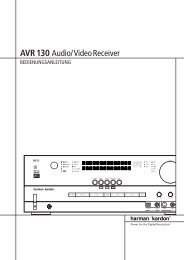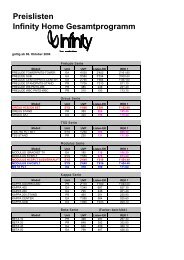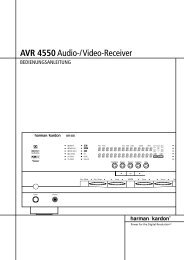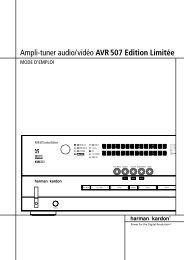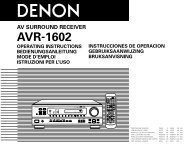Arcam AVR200 surround sound receiver Ampli-tuner audiovidéo ...
Arcam AVR200 surround sound receiver Ampli-tuner audiovidéo ...
Arcam AVR200 surround sound receiver Ampli-tuner audiovidéo ...
- No tags were found...
Create successful ePaper yourself
Turn your PDF publications into a flip-book with our unique Google optimized e-Paper software.
ReferenceBi-wiring and bi-amping loudspeakersBefore you startWARNING: Do not make any connections to youramplifier while it is switched on or connected to themains supply.Before switching on please check all connectionsthoroughly, making sure bare wires or cables arenot touching the amplifier in the wrong places (whichcould cause short circuits) and you have connectedpositive (+) to positive and negative (–) to negative.Always ensure that the volume control on youramplifier is set to minimum before starting theseprocedures.Bi-wiring your loudspeakersBi-wiring improves the <strong>sound</strong> of your system because it dividesthe high and low frequency signal currents into separatespeaker cables. This avoids signal distortions arising from thehigh and low frequency currents interacting with one anotherwithin a single cable, as in conventionally wired systems.You will need:Speakers – with four input terminals each: these will be markedHF (High Frequency) and LF (Low Frequency).Loudspeaker cables – two pairs of cables per loudspeaker(which may be joined at the amplifi er end if your amplifi er hasonly one pair of output terminals per channel). Or, a suitablyterminated cable set (a loom, probably prepared by your dealerand capable of being used for bi-wiring in one length).How to bi-wire loudspeakers1. Remove the terminal links on the rear of yourloudspeakersWARNING: This step is essential or damage toyour amplifier may result which is not coveredunder warranty.Bi-amping your systemThe performance of your system can be further enhanced overthat achieved with bi-wiring, by extending the principle one stagefurther to include separate amplifi cation for the low and highfrequency drive units in each loudspeaker enclosure.Connect the <strong>AVR200</strong> to the high frequency (HF) terminalsand connect your power amplifi er to the low frequency (LF)terminals.You will need:Speakers – with four input terminals each (as with bi-wiring):these will be marked HF (High Frequency) and LF (LowFrequency).Two amplifi ers – one of these would be the <strong>AVR200</strong> and theother an <strong>Arcam</strong> power amplifi er (e.g. an P75 or P85).Loudspeaker cables – one pair of cables per loudspeaker ora suitably terminated cable set (a loom, probably prepared byyour dealer and capable of being used for bi-amping in onelength).Interconnect cables – one pair of high quality interconnectcables.How to set up a bi-amped system1. Remove the terminal links on the rear of yourloudspeakers.WARNING: This step is essential or damage toyour amplifier may result which is not coveredunder warranty.2. Connect the cables as shown in the diagram below,ensuring correct polarity at all times.3. Use the interconnect cables to connect the AUDIO PRE-OUT sockets of the <strong>AVR200</strong> to the corresponding PWRAMP IN sockets of the power amplifi er.2. Connect the cables as shown in the diagram below,ensuring correct polarity at all times.R+<strong>Arcam</strong> <strong>AVR200</strong> <strong>receiver</strong>L+R+<strong>Arcam</strong> <strong>AVR200</strong> <strong>receiver</strong>L+––––Rightspeaker+ –HFLF –+ –+ –HFLF+ –Leftspeaker++HFLF– Right– speaker++HFLF– Left– speaker+ –+ –RL<strong>Arcam</strong> AP85 power amplifierBi-wiring using one set of connections on amplifierRecommended bi-amping configuration<strong>AVR200</strong>16



